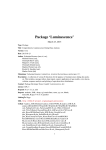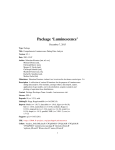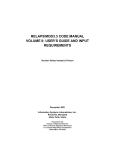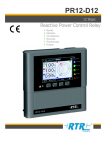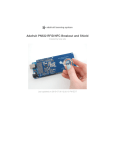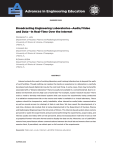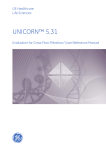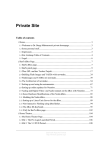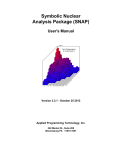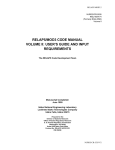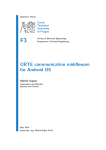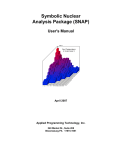Download EXTDATA Plug-in User`s Manual
Transcript
EXTDATA Plug-in User's Manual
Symbolic Nuclear Analysis Package (SNAP)
Version 2.0.5 - October 25 2012
Applied Programming Technology, Inc.
240 Market St., Suite 208
Bloomsburg PA 17815-1951
EXTDATA Plug-in Users Manual
Applied Programming Technology, Inc.
by Ken Jones and Dustin Vogt
Copyright © 2009
***** Disclaimer of Liability Notice ******
The Nuclear Regulatory Commission and Applied Programming Technology, Inc. provide no express warranties and/or guarantees and further
disclaims all other warranties of any kind whether statutory, written, oral, or implied as to the quality, character, or description of products and
services, its merchantability, or its fitness for any use or purpose. Further, no warranties are given that products and services shall be error free
or that they shall operate on specific hardware configurations. In no event shall the US Nuclear Regulatory Commission or Applied Programming
Technology, Inc. be liable, whether foreseeable or unforeseeable, for direct, incidental, indirect, special, or consequential damages, including but
not limited to loss of use, loss of profit, loss of data, data being rendered inaccurate, liabilities or penalties incurred by any party, or losses sustained
by third parties even if the Nuclear Regulatory Commission or Applied Programming Technology, Inc. have been advised of the possibilities of
such damages or losses.
Table of Contents
1.
2.
3.
4.
5.
Introduction ......................................................................................................
Using EXTDATA Files ...................................................................................
Running the Data Extractor Tool ....................................................................
EXTDATA File Format ...................................................................................
ExtDataWriter ..................................................................................................
5.1. Code Sample for ExtDataWriter ...........................................................
Index .....................................................................................................................
Data Extraction Tool Manual
1
2
3
4
6
7
11
iii
Chapter 1. Introduction
The EXTDATA Plug-in provides the ability to import external data sources into SNAP
for animation. External data could be obtained from data aquisition systems used to
record experimental data or any type of calculated data. The data must first be converted
into a Platform Independent Binary (PIB) format. The file contains a file header section,
followed by an optional section containing engineering units conversions, and then the
experimental data listed by time slice. Engineering units are defined for each data channel
using either an NRC Databank engineering units code or a reference to an embeded
engineering units conversion.
The EXTDATA plug-in is also a library that can be used to write EXTDATA files. The
class ExtDataWriter allows a simple means of writing experimental data in the proper
format.
The NRC DB Data Extractor tool is bundled with the plug-in. This application allows
creating EXTDATA ready data files from NRC Databank platform independent binary
files.
Data Extraction Tool Manual
1
Chapter 2. Using EXTDATA Files
To utilize EXTDATA files, you will need to perform the following steps in JobStatus
(or any SNAP window with similar functionality).
1.
Navigate to a mounted location on a running server containing an EXTDATA file
(such as extdata.pib, exported by the Data Extraction tool).
2.
Right-click on the folder containing the file and select Import Local File from the
pop-up menu.
3.
In the ensuing dialog, set PLUG-IN to EXTDATA, Job Name to an appropriate
name for the imported file, and Local File to the EXTDATA file itself.
The file is now listed in the folder as a completed job, suitable for use in post-processing
(such as animation).
Note
Unlike early versions of the plug-in, the EXTDATA file need no longer be
identified only as extdata.pib, and any number of EXTDATA files may
reside alongside each other in a mounted folder.
Note
The plug-in is distributed with two sample files that can be used to
demonstrate EXTDATA functionality: extdata.pib and sample.med.
Once extdata.pib is imported as a local file, it can be used as a Data Source
in sample.med and animated.
Data Extraction Tool Manual
2
Chapter 3. Running the Data Extractor
Tool
The Data Extractor utility can be used to convert several forms of data files directly to
EXTDATA files. The method of launching the application varies slightly depending on
the user's platform. The following are all valid:
•
On Windows, a Data Extractor item is added to the Start Menu in the SNAP folder.
•
For *NIX systems with GNOME or KDE, the installation creates similar menu
items.
•
All other users can launch the application directly through the "dataextractor"
launchers found in the SNAP installation's bin folder.
Data Extractor usage and features are detailed more thoroughly in the application's own
documentation.
Data Extraction Tool Manual
3
Chapter 4. EXTDATA File Format
The EXTDATA_PLUGIN expects the data file to be an XDR binary file conforming to
the following format. Various housekeeping information is written to the file, but it has
the following basic structure: a file header, an optional code listing, and a block of data
for each slice of time in the experiment.
Note
Unlike early versions of the plug-in, the EXTDATA file need no longer be
identified only as extdata.pib, and any number of EXTDATA files may
reside alongside each other in a mounted folder.
The file header is always expected to be the first block of information in the file (to that
end, an ExtDataWriter throws an exception if a program attempts to write a block of data
before writing the file header). This header tracks a number of values tied directly to the
plug-in's read methods. It is generally absolutely necessary for the file header to contain
accurate information. It stores the following values:
•
Facility. Where the experimental data was recorded.
•
Experiment. The experiment to which this data corresponds.
•
Description. A description of the experiment.
•
Unit Source. The source of this data's engineering unit codes.
Note
Unit Source has replaced the NRC DB EU Codes flag of the previous
version of the plug-in.
•
Experiment start time. Start time for the experiment.
•
Experiment end time. End time for the experiment.
•
Number of time slices. The number of time slices between the start time
and the end time, inclusive.
•
Channel headers. Explained below.
A channel header describes a data channel. The file header stores a sequential listing of
all channel headers in the experiment. The first channel must be time. Channel headers
store the following information:
•
Name. The name of the data channel.
•
EU Code. The engineering unit code. This code directly corresponds to a
conversion set specified by the Unit Source. Normally, this refers to NRC Databank
EU codes, but may also directly reference custom units embedded directly in the file.
Data Extraction Tool Manual
4
EXTDATA File Format
A file is expected to have an engineering unit code listing if the file header indicates
that the data is to utilize an embedded code listing. Each unit code has the following
information:
•
Engineering Unit Code. The index of this engineering unit code. This value
must be non-negative and unique among EU codes in the file.
•
Unit Description. A short description of the unit code, usually the name.
•
SI Label. Label for this unit in the SI system of measure (ex: m for meters, N
for newtons, etc.).
•
British Label. Label for this unit in the British system of measure (ex: ft for
feet, lb for pounds, etc.).
•
Storage Type. Integer tracking whether the value written to the file is stored in
SI or British units. For SI values, this must be 0; for British values, this must be 1.
•
Conversion Factor. The conversion factor, explained more below.
•
Conversion Offset. The conversion offset, explained more below.
The conversion factor and offset merit some explanation, as these have changed in
semantics from legacy versions of the plug-in where custom unit codes could be written,
but not utilized directly in SNAP. The conversion factor and offset are used such that
values can be converted from practically any form of measurement, including scales with
arbitrary offsets, such as temperature. The factor and offset are always interpreted in
very specific means and order: the conversion values must directly convert SI values to
British units. The equations used to perform the conversions are as follows:
ValueBritish = (ValueSI * Factor) + Offset
ValueSI = (ValueBritish - Offset) / Factor
These are consistent with the above requirement that the factor and offset directly
transform SI values to British units.
The final segment of the file will usually make up the bulk of it: data for time slices. Each
data block is an array of double-precision floating point numbers. The array length must
exactly match the number of data channels listed in the file header. The first element of
the data block is always expected to be the time for that slice of data. The elements of
the data block must be in order corresponding to the data channels listed in the header.
These data slices must be written in sequential order according to time.
Data Extraction Tool Manual
5
Chapter 5. ExtDataWriter
The ExtDataWriter class has been written to streamline the process of writing data to
a PIB file. Instances will throw ExtDataWriterException (a checked exception) for a
variety of failures. Its public methods are as follows:
•
ExtDataWriter(). Create an intance of ExtDataWriter.
•
ExtDataWriter(String filename). Create an instance of ExtDataWriter
with the target file specified by the parameter open for writing.
•
boolean isOpen(). Returns true if a target file is open. Returns false otherwise.
•
boolean isHeaderSet(). Returns true if a file has been opened and its file
header has been written. Returns false otherwise.
•
boolean isUsingNrcCodes(). Returns true if a file has been opened, its
file header has been written, and the file is expected to use the NRC Databank
engineering unit codes. Returns false otherwise.
•
boolean isOtherCodeSet(). Returns true if a file has been opened, its
file header has been written, the file is not expected to use the NRC Databank
engineering unit codes, and the alternative code list has been written. Returns false
otherwise.
•
String getUnitSrc(). Returns the unit source of the data file if the file
header has been written. Current values include: ExtDataWriter.NRCDB,
ExtDataWriter.EMBEDDED, and ExtDataWriter.RELAP5. Returns null
otherwise.
•
void openFile(String fileName). Opens a new file for writing. Closes
a preexisting open file.
•
void writeFileHeader(String facility, String experiment,
String description, String unitSrc, double startTime,
double endTime, int numTimeSlices, String[] channelNames,
int[] euCodes). Writes a file header with the given information. The array
arguments must be parallel and equal length; the first element is expected to be time.
The other parameters correspond to the above mentioned values. Various constants
have been provided for unitSrc in the ExtDataWriter class: NRCDB, EMBEDDED,
and RELAP5. Other constants may be added in a future release.
Throws ExtDataWriterException if no file is open, if the file header has
already been written, if channelNames and euCodes do not have matching length,
or if the write fails.
Note
String
versions.
Data Extraction Tool Manual
unitSrc has replaced boolean
nrcCodes of legacy
6
ExtDataWriter
•
void writeDataBlock(double data[]). Writes a block of data pertaining
to one time slice to the target file. The argument data must be at least as large as the
expected number of data channels, preferably exactly equal and corresponding in
order to the data channels specified in the file header; excess elements are discarded.
Throws ExtDataWriterException if no file is open, the header has not been
written, the file does not intend to use the NRC Databank Engineering Unit Codes
and no code list has been written, data has less values than expected, or if the write
fails.
•
void writeData(double data[][]). Writes several blocks of data to
the target file. The two dimensional array passed as the argument should have
the following form: the first dimension corresponds to the time slices, the second
dimension corresponds to the values for that time slice, where the first element
should be time. data must be at least as wide as the expected number of channels,
preferably exactly equal and corresponding in order to the data channels specificed
in the file header; excess elements are discarded.
Throws ExtDataWriterException if no file is open, the header has not been
written, the file does not intend to use the NRC Databank Engineering Unit Codes
and no code list has been written, data has less values in its second dimension than
expected, or if the write fails.
•
void writeCodeList(UnitCode[] codes). Writes a list of engineering
unit codes to the target file if the data is not intended to utilize the NRC Databank
Engineering Unit Codes. This method should not be called until a file header is
written with its unitSrc set to ExtDataWriter.EMBEDDED, and must be called in
that event before any data is written.
Throws ExtDataWriterException if the file is not open, the header has not
been written, the file is not marked as using an embedded code listing, the code list
has already been written, or the write fails.
•
void
close(). Closes the file. Should be called explicitly when the
ExtDataWriter is no longer of use.
5.1. Code Sample for ExtDataWriter
The following is a code sample detailing the use of the ExtDataWriter class. This file is
also included with the plug-in installation in the Samples folder.
// Copyright (c) 2002-2005 Applied Programming Technology, Inc.
// All rights reserved.
import com.cafean.extdata.io.ExtDataWriter;
import com.cafean.extdata.io.ExtDataWriterException;
/**
* A sample program of how to use the ExtDataWriter class for writing data to a
* file.
*
Data Extraction Tool Manual
7
ExtDataWriter
* @author APT, Inc.
*/
public class ExpFileSample
{
public static void main(String[] args)
{
double currentTime = 0.0;
double timeIncrement = 1.0;
String facility = "APT, Inc.";
String experiment = "Example Experiment";
String description = "Sample data for ExtDataWriter example.";
// Current options are ExtDataWriter.NRCDB, ExtDataWriter.EMBEDDED, and ExtDataWriter.RELAP5
String unitSrc = ExtDataWriter.NRCDB;
double startTime = 0.0;
double endTime = 9999.0;
int numTimeSlices = 10000;
// Note that the end time might be expected to be an exact value of
// 10.0. In this example the actual end time generated by incrementing
// 0.0 by 0.1 a thousand times is actually closer to 9.98 due to round
// off error. It is up to the user to insure that the set end time and
// the actual end time agree.
// Channel headers to be stored in the file header.
String[] cHeaderNames = new String[5];
int[] cHeaderCodes = new int[5];
cHeaderNames[0] = "Time";
cHeaderCodes[0] = 36; // Corresponds to time in the NRC Databank EU Codes.
cHeaderNames[1] = "Frequency";
cHeaderCodes[1] = 56;
cHeaderNames[2] = "Current";
cHeaderCodes[2] = 11;
cHeaderNames[3] = "Pressure";
cHeaderCodes[3] = 3;
cHeaderNames[4] = "Mass";
cHeaderCodes[4] = 46;
// Open the file.
ExtDataWriter dataWriter = new ExtDataWriter("extdata.pib");
// Write the file header.
try {
dataWriter.writeFileHeader( facility, experiment, description,
unitSrc, startTime, endTime,
numTimeSlices, cHeaderNames,
cHeaderCodes );
} catch(ExtDataWriterException e) {
e.printStackTrace();
return;
}
//
//
//
//
//
//
//
//
//
//
//
//
//
//
// If the data is not to be tied to the NRC databank engineering unit
// codes, a CodeList must now be written to the file.
// Note: a more practical use would have to include a definition for Time.
//
This sample is more interested in demonstrating units with conversions.
UnitCode[] uCodes = new UnitCode[2];
uCodes[0] = new UnitCode();
uCodes[0].setEuCode(1); // All EU code values must be both unique and non-negative.
uCodes[0].setEuType(0); // 0 for values written to the file in SI, 1 for British
uCodes[0].setUnitDescription("Length");
uCodes[0].setSiLabel("cm");
uCodes[0].setBrLabel("in");
uCodes[0].setConversionFactor(0.393700787);
uCodes[1] = new UnitCode();
uCodes[1].setEuCode(2);
uCodes[1].setEuType(0);
uCodes[1].setUnitDescription("Temperature");
uCodes[1].setSiLabel("C");
uCodes[1].setBrLabel("F");
Data Extraction Tool Manual
8
ExtDataWriter
//
//
uCodes[1].setConversionFactor(1.8);
uCodes[1].setConversionOffset(32);
//
//
//
//
//
//
//
//
//
//
//
//
A note about conversions. Units can be entered to convert between
practically any units of measurement, including scales with offsets,
such as temperature. However, for the sake of clarity, all
conversions must be entered so that they convert from SI units to
British units, regardless of which type of unit is used to store
the value in the file.
The conversion formulae used are:
SI to British: (value * factor) + offset
British to SI: (value - offset) * factor
These expressions are consistent with the requirement that all
conversion values translate from SI to British.
// The following writes the units list.
try {
dataWriter.writeCodeList(uCodes);
} catch(ExtDataWriterException e) {
e.printStackTrace();
return;
}
//
//
//
//
//
//
// Generate data and write data.
for(int i = 0; i < numTimeSlices; i++) {
// Can only have as many elements as data channels.
double exampleDataSlice[] = new double[5];
// Generate dummy data.
exampleDataSlice[0] = currentTime;
exampleDataSlice[1] = Math.sin((double)i/10.0);
exampleDataSlice[2] = Math.cos((double)i/10.0);
exampleDataSlice[3] = Math.sin((double)i/5.0);
exampleDataSlice[4] = Math.cos((double)i/5.0);
currentTime += timeIncrement;
// Write data.
try {
dataWriter.writeDataBlock(exampleDataSlice);
} catch(ExtDataWriterException e) {
e.printStackTrace();
return;
}
}
/* Alternatively, the following could have been used:
*
* double exampleData[][] = new double[1000][4];
* for(int i = 0; i < exampleData.length; i++) {
*
// Generate data.
*
exampleData[i][0] = currentTime;
*
exampleData[i][1] = Math.sin((double)i/10.0);
*
exampleData[i][2] = Math.cos((double)i/10.0);
*
exampleData[i][3] = 2*Math.sin((double)i/5.0);
*
currentTime += timeIncrement;
* }
*
* // Write data.
* try {
*
dataWriter.writeData(exampleData);
* } catch(ExtDataWriterException e) {
*
e.printStackTrace();
*
return;
* }
*/
// Housekeeping.
dataWriter.close();
}
Data Extraction Tool Manual
9
ExtDataWriter
}
Data Extraction Tool Manual
10
Index
I
introduction, 1
Data Extraction Tool Manual
11














